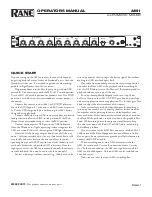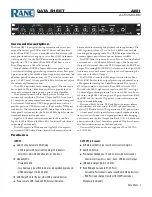
12.5.4 Output
The output impedance is low but varies with the setting of the A40 control in
the case of the Amplifier C1. The output will deliver at least 2.4V r.m.s. into a load
of 3k
Ω
. The output of an Amplifier C is in phase with the input of the Amplifier B
preceding it.
12.6 Amplifier Type E
12.6.1 Purpose
In order to maintain the nominal level within the Mixer it is necessary to
provide 5dB gain after each fader since the faders, when set to “0”, introduce 5dB of
loss. The Amplifier E is used to provide this gain in the Microphone Cassette
where, in order to maintain correct overall poling, an amplifier is required which
does not reverse the phase. (See 12.12, Amplifier K for phase reversing amplifier
used in Group and Main Cassettes.)
12.6.2 Circuit
The Circuit diagram is shown as Drawing No. AE.207.
12.6.3 Circuit Description
The circuit comprises two d.c. coupled transistors, d.c. coupled feedback
being provided by connecting the emitter of the input transistor to a tapping on the
load in the collector circuit of the output transistor. The base of the input transistor
is held at –10V by R2 and R3. Input and output coupling capacitors are provided.
The AOT resistor R7 is initially 51k
Ω
±
2%. On overall test of the complete cassette
a value is chosen to set the channel gain to the nominal figure. R1, R2 and R3 in
parallel present an input impedance of 50k
Ω
this being the load into which the fader
is designed to give its indicated attenuation.
12.6.4 Output
The output impedance is low. The output will deliver at least 2.2V r.m.s. into
a load of 2.4k
Ω
. The output is in phase with the input.
12.7 Band Pass Filter (F)
12.7.1 Purpose
This filter serves two purposes. Firstly, it provides 12dB per octave
attenuation below about 25Hz and above about 25kHz to reduce the risk of trouble
from sub-audio rumble and from r.f. interference. Secondly, it provides the means
for trimming the overall frequency response of a channel.
















































